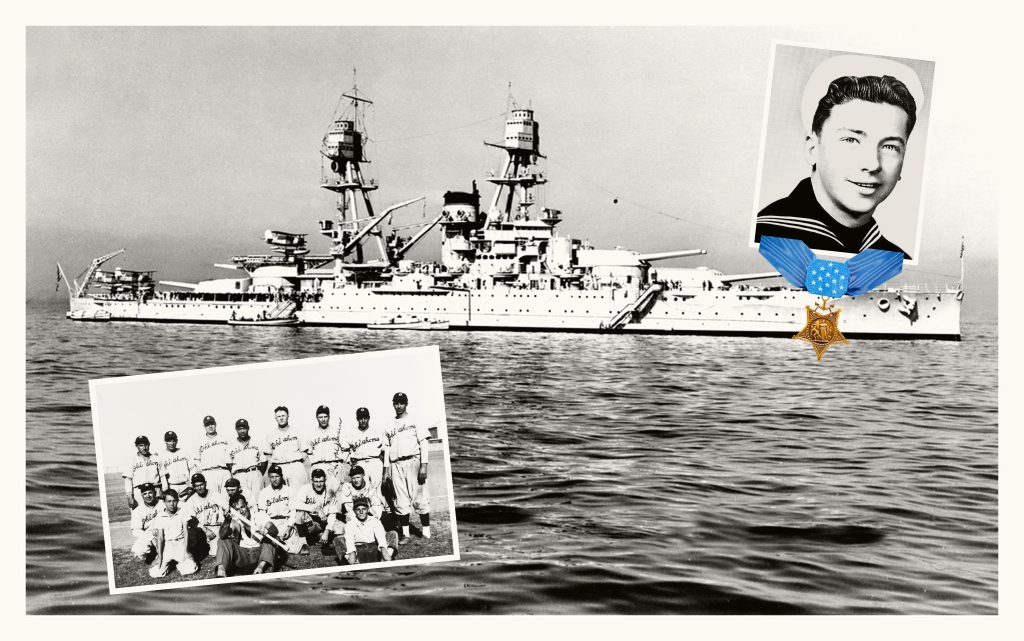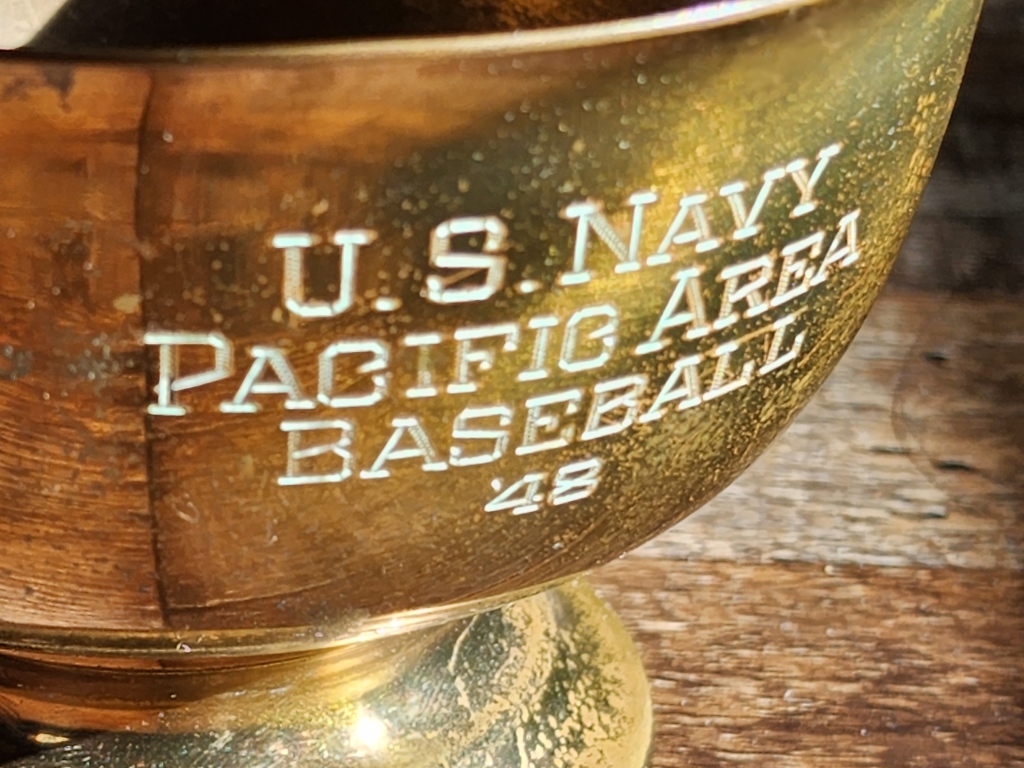A note to our readers: This is a follow-up to our piece, A Sinking News Story: World Series Hero Gene Bearden, a Sub-Chaser and the Loss of the USS Helena as new evidence has been brought to our attention.
Accuracy and completeness. Throughout the six years that we have been researching artifacts, teams and players, we have taken great strides to ensure that we bring to bear and exhaust each research avenue that we have at our disposal in order to publish content that is both accurate and complete. In the absence of supporting facts, we have opted to sit on stories rather than to publish something that contains erroneous or unsupported information or to wait until we are able to find substantiating evidence. In six weeks of tireless research and story development, we were satisfied that we had excavated everything about Gene Bearden’s USS Helena story, citing our inability to locate the origin of the narrative. However, within 12 hours of publishing our latest article, one of our readers, Charlie Burrow. located what we were unable to find – the connection to Bearden as the originator of the USS Helena narrative.

Tribe’s War-Mangled Bearden Hid Injuries Behind Big Curve
Making his major league debut as a starting pitcher, Gene Bearden pitched a very good game, lasting 8-2/3 innings on the road against the Washington Senators on May 8, 1948. The Navy veteran limited Senators batters to just three hits while walking four. He struck out five and allowed Washington’s only run as the Indians beat the “Nats,” 6-1. Not only was he marvelous on the mound, but he also got his first major league hit and drove in his first RBI off Sid Hudson as part of Cleveland’s 5-run scoring spree in the eighth inning.
Naturally, the eyes of the press focused upon the Indians’ rookie knuckleball pitcher following his impressive debut. Sportswriter Harry Jones of the Cleveland Plain Dealer had a high-quality story about Bearden’s first career win and also something far deeper that would draw the attention of Americans from coast to coast. Whatever was lacking in the October, 1948 narratives about Bearden’s harrowing experience on the USS Helena, Harry Jones’ May 9, 1948, article ensured that no doubts existed about the pitcher being the story’s originator.


Jones reported that Bearden, “was in the ship’s engine room when it was struck by a torpedo” and was given orders to abandon ship. In fact, three Japanese torpedoes struck the ship within a span of three minutes, breaking the ship’s keel, opening the propulsion machinery spaces to the sea and causing rapid flooding. With both engine rooms filling with water, the ship’s propulsion and electrical power were knocked out. Two minutes after the third torpedo struck the ship, the commanding officer gave the order to abandon ship.
Harry Jones described Bearden’s ordeal. “Given instructions to abandon ship,” Jones wrote, “Gene began to climb a metal ladder leading out of the engine room when a second torpedo struck. The ladder crumbled and he was hurled to the floor below.” The narrative continued, “His knee was twisted and crushed and his head was split open by flying fragments and he lay unconscious in the pit of the sinking ship.”

The published accounts of Helena’s final moments do not align with the story written by Jones. Within two minutes of the first torpedo striking the ship, flooding was so massive in the forward engine room that seawater began to reach engine room number two before the second and third torpedoes struck roughly 120 seconds after the first crippling shot. Bearden’s story suggests that he had time to climb a ladder that was subsequently blown apart, throwing him to the deck of the space. However, those spaces were rapidly flooding and the deck was several feet beneath in-rushing seas. With the ladder destroyed, somehow Bearden, 6-4 and 198 pounds, was carried from the depths of the darkened, flooding and sinking ship and led into the waters of the Kula Gulf sometime after 2:00 a.m. as the Helena was breaking apart less than 15 minutes from the impact of the first torpedo.
“Somebody pulled me out,” Gene said. “They told me later it was an officer. I don’t know how he did it. The ship went down in about 17 minutes. All I know is that I came to in the water some time later.”
– Gene Bearden, Bearden’s Secret is Out: Torpedo Can’t Stop Him, Cleveland Plain Dealer, May 9, 1948
Bearden’s story takes him from being in the water to spending two days adrift in a life raft before being transported back to the States and to a Jacksonville, Florida-area hospital, where he was advised that his baseball career was effectively over due to the severity of his wounds.
“I don’t know how many doctors told me that,” Gene said. “I didn’t know what to do. I learned a trade in the Navy, but baseball was the only thing I had known. Finally, I ran across a doctor who said he might be able to patch me up well enough. I think his name was Wyland. He was quite a guy. He worked with me for months.”
– Gene Bearden, Bearden’s Secret is Out: Torpedo Can’t Stop Him, Cleveland Plain Dealer, May 9, 1948
The road to recovery, according to Jones’ article, was a lengthy one, with Bearden suffering damage to his kneecap that “had been crushed beyond repair.” The Plain Dealer piece continued, “The ligaments in his leg had been so badly mangled that an aluminum cap and screw were inserted.” Bearden’s skull trauma was so severe that “the aluminum plate was inserted where his skull had been gouged open,” wrote Jones in describing Bearden’s wounds. Following surgical procedures, Bearden reportedly spent the first month in bed. “For two more months, he wore a plaster cast, but was able to maneuver with crutches, then a cane,” the story continued. With Bearden arriving in Florida sometime in August of 1943, it was not until March of 1944 that he was able to walk unaided.
According to Jones, Bearden was not discharged from the hospital until January, 1945, following “a series of leg exercises which gave him full use of the limb.” Weeks later, Bearden was pitching for the Binghamton club, starting an Impressive 8-game winning streak.

Bearden Perfects Knuckler in Bid for Tribe Mound Job
Surprisingly, the May 9, 1948, story was not the initial source of the Cleveland newspaper account of Bearden’s wartime experiences. On April 11, Harry Jones reported a slightly different USS Helena account. “We were chasing a couple of Jap tin cans (submarines),” Bearden relayed.
“Somehow we got right between ‘em and they let us have it, but good. The ship went down in 16 minutes. I was in the engine room and had started up the ladder when we got hit. The next thing I remember I was in the water. They told me afterward that a chief pulled me out of the engine room and got me on a raft just before the ship went under. We were in the water for the next three days and I was unconscious just about half the time. Finally we got picked up and that was the end of the war for me.”
– Gene Bearden, Bearden Knuckles Down to Capture Job, Cleveland Plain Dealer, April 11, 1948
The variation of details between the two stories told weeks apart would not typically be cause for concern; however, without official Navy documentation to support Bearden’s claims, alterations to the narrative become suspect.
Focusing solely on these two published accounts with Bearden’s commentary, it is clear that the pitcher was responsible for the origin of the USS Helena story. Strangely, another published account accompanied the two 1948 Plain Dealer articles. It leaves us questioning Bearden’s motive behind the false narrative.

Bears Get Bearden, Navy Vet – Twice Torpedoed, Rescued as Ships went Down
Following Bearden’s fantastic season with the Binghamton Triplets, he was sold to the Newark Bears. Seeking to introduce the club’s new pitcher to Newark fans, William Klein of the Newark Star Ledger published Bearden’s wartime account, titled Bears Get Bearden, Navy Vet on September 6, 1945. Aside from a few minor variances from the 1948 story, Klein told of Bearden’s year-long hospitalization in the aftermath of his survival ordeal from the Helena. From this point, the story had a confusing twist.
“After a year’s hospitalization,” Klein stated, “he was assigned to the Elliot and again was fished out of the Pacific when an aerial torpedo sent the destroyer to the bottom.” However, the USS Elliot (DD-146), one of the many destroyers present at Pearl Harbor on December 7, 1941, was serving as a training ship from August, 1944 to June, 1945. USS Elliot was decommissioned on October 12, 1945 and was sold for scrap in 1946. “Bearden was hardly scratched,” Klein wrote, “except for both legs broken, his right arm shattered in several spots and a severe back injury. After another long hospital siege, he was discharged.”
When the National Military Personnel Records Center (NMPRC) re-opens, Freedom of Information Act (FOIA) requests will be made in an attempt to clear-up the unknown details such as the nature of Bearden’s discharge and to confirm each of his training and duty stations.
Today, society can be far too swift to disparage a veteran with accusations of “stolen valor” as it levies attacks on service members who embellish their service careers. While there is certainly enough evidence to point fingers at Bearden as the author of a fallacy, he did serve his country honorably during one of the most challenging periods of our nation’s history. Motor Machinist’s Mate 3/c Bearden did serve aboard a Navy ship sailing into harm’s way and was aboard when she was involved in a destructive collision that could have easily resulted in the loss of life including his own.




Leave a comment